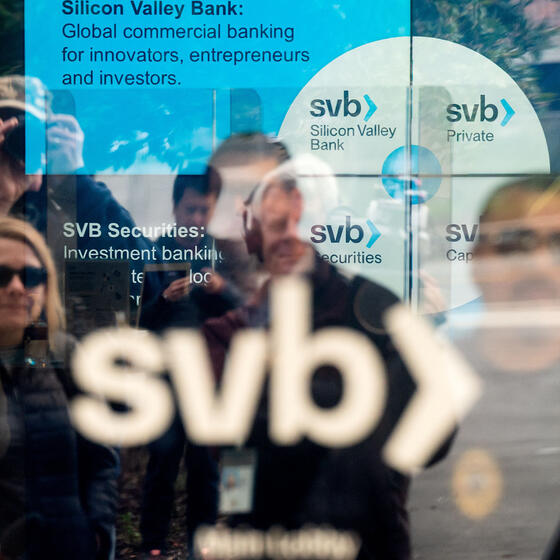What’s Next for the Startups That Banked with SVB?
For two days after the run on Silicon Valley Bank, hundreds of startups faced the prospect of losing millions and even billions of dollars of uninsured deposits in the bank. Federal intervention restored access to those funds, but Yale SOM’s Song Ma says there are important lessons in the episode for founders, starting with diversifying their financial relationships.

Customers at Silicon Valley Bank headquarters in Santa Clara, California on March 13.
Are the startups that were threatened by the collapse of Silicon Valley Bank out of the woods?
I think so, after the joint statement by Treasury, Federal Reserve, and FDIC on Sunday, March 12. We can debate the pros and cons of this decision itself, but it was a big relief for startups.
Roll back two days to Friday, March 10, when startups and the whole startup ecosystem were at the center of the discussion and many tech startups were scrambling. Hundreds of startups had large amounts of uninsured deposits with SVB. The collapse of SVB, without the intervention, could have meant difficulties in meeting payment needs like payroll, contracts, etc. in the near term.
One byproduct of the collapse of SVB is the loss of a ‘financial hub’ in the tech startup ecosystem. SVB provided important expertise to the startup community and developed deep relationships with the community, which are difficult to rebuild in the short run.
Did this crisis reveal longer-run vulnerabilities for the startup ecosystem?
I think this (hopefully) short-lived crisis is more of a natural consequence, or reflection, of the struggling startup community in the past 12-18 months. As my colleague Andrew Metrick correctly pointed out in another Yale Insights article, SVB depositors, many of which are younger firms in the tech sector, faced a difficult funding environment last year—2022 global VC funding experienced a 30% decline from 2021, and 2022Q4 was a five-year low point of VC deals—and this trend is continuing in 2023. These startups needed to withdraw unusually high levels of cash from SVB, which partially led to the SVB problem.
One byproduct of the collapse of SVB is the loss of a “financial hub” in the tech startup ecosystem. SVB provided important expertise to the startup community and developed deep relationships with the community, which are difficult to rebuild in the short run. This could pose a challenge to VCs and startup founders who are used to working with SVB for their financing needs. I believe preserving these is in the minds of many—the unconfirmed news that several major PE and VC funds are interested in forming a consortium to bid for SVB could be an important step toward doing so.
What are the lessons for founders?
For startup founders and executives, there are a few lessons to be remembered. They are hardly new lessons, but this is a good time to go back to these principles. First, watch your cash—your cash balance, burn rate, contingency plans (build it with existing VCs and other shareholders), among other things. This is particularly relevant when VC funding is getting tough to get. Second, diversify your deposits—this not only helps with the deposit insurance cutoff (the $250,000 limit that everyone knows about now!), but can help build relationships with a few more financial institutions.